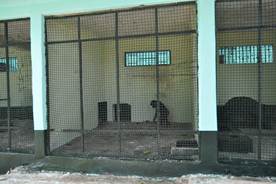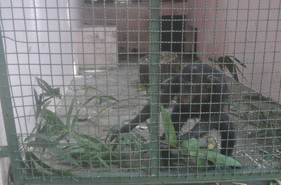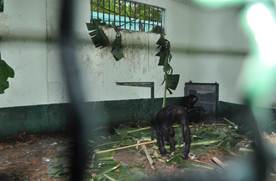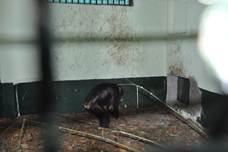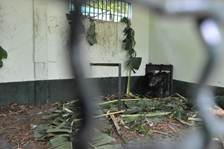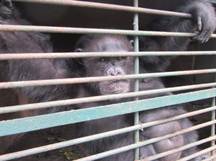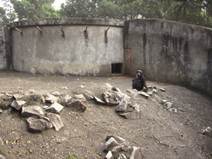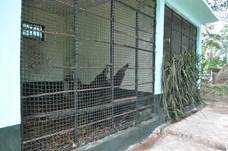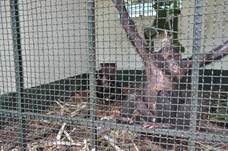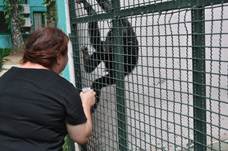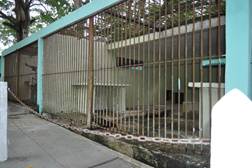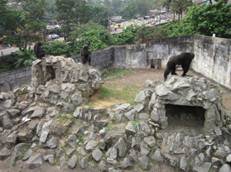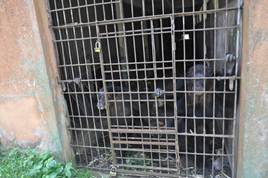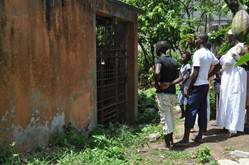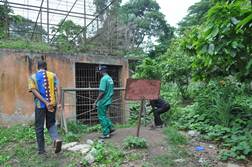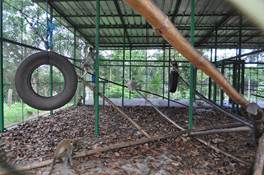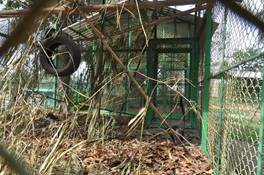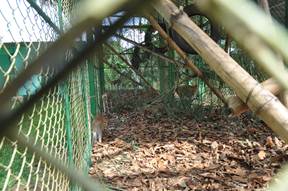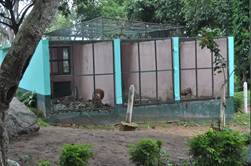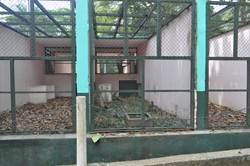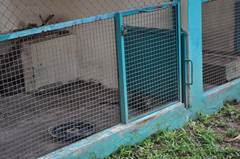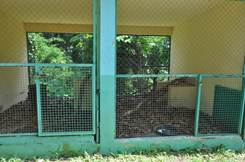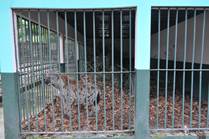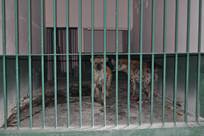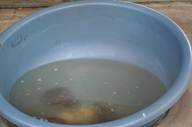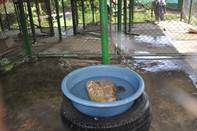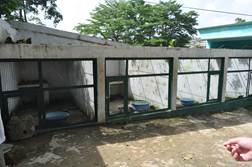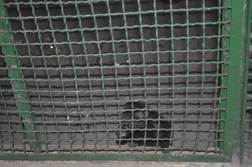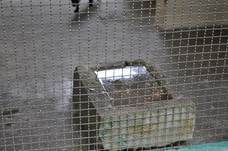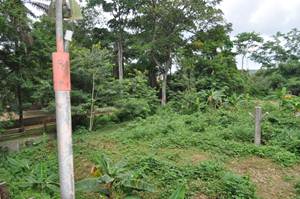
|
Hilda Tresz Global Volunteer Work | ||||||||||
| Argentina | Brazil | Chile | China | Egypt | India | Ivory Coast | Qatar | Russia | Senegal | United Arab Emirates |
|
Ivory Coast | |||||||||||||
|
Abidjan
Zoo 6-17-12
The
purpose of the visit was to introduce singly housed chimpanzees or
any other primates into group settings as well as to reorganize
basic husbandry routine and starting an enrichment plan for all
species.
Richard
Champion, zoologist from the UK left a week earlier prior my
arrival to help refurbish the chimpanzee complex and other
facilities to enable the movement of primates.
Chimpanzees (Pan
troglodytes verus) Upon arrival, most chimpanzee cages were not ready yet due to lack of access to funds of Swiss bank account. Richard (Zoologist, Project Manager of Abidjan Zoo) and I needed to wait an additional 4 days before construction could start. Cages needed doors to connect as well as some new bars or at least bar support to hold chimpanzees. While waiting for the doors to be installed, we worked on other species. Regarding chimpanzees, by the day I was leaving, we got as far as fixing the first 3 cages (out of 6), introducing two sub-adult chimpanzees Sidibe and DJ (age 8-10) and transfer female chimpanzee Judith (age 39) next to them.
Photos
by Hilda Tresz
We
placed dry leaves for substrates, browse for foraging and nest
building, logs and larger branches and a tire for furniture, and
some boxes for toys. Sidibe was transferred next to DJ and the
introduction went well. The following day, Judith was transferred
next to the two young animals and they interacted through the
mesh. Unfortunately, I had to leave on the same afternoon and had
no time to do more.
Suggestion: to further improve quality, permanent and flexible
furniture needs to be installed to each cage. Animals need both in
order to develop/exhibit proper motor skills.
In most of
the exhibits/displays, animals can only use floor space. Exhibits
should utilize three dimensions by adding large tree trunks,
ropes, fire hoses, hammocks, wooden shelves, etc., to increase
space and to the animals’ opportunities for exercise,
exploration and manipulation. Furniture needs to be built from
wood, ropes or any kind of natural materials as opposed to metal.
DJ
just realized they had a neighbor!
Supporting each other. Photos by Hilda Tresz
Judith
had some behavioral problems. Although she had a large exhibit,
she chose to lock herself into a dark night house, coming out most
of the time only if someone called her and then locked herself
back again. In order to ease her into her new situation, we
blocked her cage half way from the public to give her privacy
should she choose to retire. She used it quite often, but also was
interested in her young neighbors.
Judith
is morbidly obese. Photo by Richard Champion
Judith's old exhibit. Photo by
Ban
Dagui Simone
Judith
in her new home. Photo by Hilda Tresz
The
hope is that having two young and active animals next to her (and
later with her) she will recover mentally as well as will start to
be active and lose weight. DJ and Sidibe also needed a surrogate
mother so hopefully they will get along well.
When she will be introduced later, she will need to be separated
at night or even a few times during daytime from the young ones to
"catch her breath" or to have a good night sleep,
unless, again, she will show signs that she prefers it otherwise
(such as not wanting to separate from the young ones, won’t let
keepers to close the door, etc.) or until she is comfortable with
her new situation.
Sidibe
had some sever skin problems. He was being medicated orally but
still was itching badly. A spray bottle with oil/water mixture was
purchased and the animal was trained to accept to be sprayed. The
time training was finished; he enjoyed it so much, he offered his
body parts to be treated and considered it as something fun. He
decreased his itching significantly. Suggestions:
Sidibe should be sprayed at least once per day with this mixture.
Sidibe
is being trained to accept moisturizer from spray bottle. Photo
by Hilda Tresz and Elie Bogui
Two
empty cages that need repairs at other side of chimpanzee
building. Photo by Hilda Tresz
There
was not much time to consider the rest of the chimpanzee groups.
Since they were already in social groups, after basic husbandry
was improved, attention was directed to all other species.
Suggestion:
Due to various circumstances, current social sex ratios are not
easy settings on females (having large numbers of males living
with them and competing for them). If obtaining additional females
is not feasible, the number of group members might have to be
decreased to pairs and bachelor parties will need to be created.
Transferring the chimpanzees was a difficult task due to lack of veterinarian staff as well as funds to call a veterinarian and immobilize that many chimpanzees at the same time. There was not enough money to pay a vet to do all of these or buy enough drugs. At a different enclosure, further away from the chimpanzee building, there was a large exhibit with another group of chimpanzees (1.0 Sam 18 - 20 years old; 1.0 Nimlin 18 -20 years old; 0.1 Bras-long 38 year old and 0.1 Grâce 1 years old). The exhibit is quite large, mainly consist of concrete and rockwork and it is practically un-cleanable due to having no access to it. Door between night house and exhibit is broken therefore keepers cannot lock animals inside and enter. All fecal matters and public waste products remain on exhibit. The night house has no light, stall doors are broken and some of the bars were ripped off or bent out of shape by the animals.
These
chimpanzees have poor health conditions; some are diabetic and
need improvements to their diet. The lactating female and her
infant will also need supplemental nutrition because infant is
weak and has a hard time clinging.
Suggestions: All chimpanzees need to receive milk and hard boiled
eggs for protein. It is quite cheap and accessible. These animals
need to be separated for feeding time so alpha male would not be
able to monopolize desired food items or at least keepers should
chop diet and scatter. Also, sire of female infant needs to be
moved out of the group or be vasectomised (not castrated) before
infant will reach sexual maturity (in captivity could be as early
as 5.6 years old [Earnhardt, 2003]. Castration does not guarantee a calmer animal:
indeed, a male can end up being just as aggressive as he was prior
to castration (Grow, 2004).
Large
chimpanzee exhibit. Photo by Richard Champion Holding area is dark
and animals cannot be separated. Photo by Hilda Tresz
Other
species
All
cages were filed with substrate, browse, logs and branches.
here were three very young monkeys such as patas monkeys
(Erythrocebus
patas); vervet
monkeys (Chlorocebus
pygerythrus),
and lesser
white-nosed
monkeys? (Cercopithecus
petaurista) separated from their groups. They
are now together with their conspecifics except the alpha male
patas monkey that was still recovering.
Suggestions: Alpha male patas monkey was still separated after I
left, he needs to be introduced with the group please.
Young
vervet monkey with conspecifics Young white-nosed monkey
introduced to group. Photos by Hilda Tresz
Young
patas monkey introduced to group while large male is still housed
next to them. Photo by Hilda Tresz
Some
additional patas monkeys were housed on the other side of the
building (below) in similar size cages. Once they were moved out
to the young monkeys’ cages, the Nile monitors
(Varanus
niloticus)
were transferred over. The monitors now have access to all three
cages and deep bedding.
Single
olive baboon (Papio
anubis),
is
now also having all three cages due to Sidibe’s moving across
with DJ. This animal developed severe behavioral problems in the
past possibly due to being hand reared, then given to the zoo and
kept being isolated.
Single
olive baboon and Nile monitors with bedding. Photos by Hilda
Tresz
Suggestion: This animal should not be kept in solitary
confinement for the rest of his life. There was much debating over
his current and future welfare. A general agreement was made that
if he cannot be shipped out or paired up with other female
baboons, euthanasia will need to be considered.
Civet cages without and with substrates. Photos by Hilda Tresz
Hyenas
also received substrates and furniture. An introduction was also
attempted, but was not successful and the animals needed to be
separated again. Photos by Hilda Tresz
There
was no immediate solution for current turtle (species?)
situation. There were no cages with mesh small enough to
retain them and all exhibits with water supplies (other pools) had
some type of species that could have predated on them if
introduced. The best temporary solution was to at least provide
some terrain when animals are given a choice to be on dry land or
in water. The only cages that could be sufficient enough to hold
small animals are the current snake enclosures but than again,
there are no current facilities with correct mesh sizes that the
snakes could be transferred to either.
Turtles
were given clean water and terrain. Photo by Hilda Tresz
Current
snake cages that could hold small animals in the future such a
baby civet (Civettictis civetta)
that is held in the grain room due to lack of space. Photos by
Hilda Tresz
Water
supply for animals
Concrete
waters are difficult to clean and won’t offer unlimited water
supply. Photo by Hilda Tresz
Most
cages only have concrete containers that are not cleaned well and
often, and some animals only get a drink from water bottles maybe
twice a day in this high temperature climate, and have no access
to water at all from late afternoon till next morning. Suggestion: All animals need to have access to drinking water 24 hours a day from automatic waterers and proper furniture. Please review information regarding Lixit Automatic Dog Waterer for Outdoor Faucets & Spigots available at
Gun
Dog Supply
Substrate.
Continuing keeping animals off of hard/ cold/ wet/ dry, unyielding
surfaces (concrete, tile, wood floor, etc.) would be desirable.
The use of appropriate substrate (inside- paper products
and hay or straw, etc.; outside- nonflammable materials such as
sand, soil, mulch, fresh browse, etc.) will make a significant
difference not only in the animals’ health but would improve the
aesthetics of the exhibits. The substrate presentation is
available for the zoo’s convenience. Browse.
The zoo has large amount of edible vegetation available on grounds
that could provide fresh, leafy branches (browse) at least every
2-3 days but if possible, every day. As mentioned during the
presentation, the zoo can start planting edible trees,
bushes and even crops inside and outside of exhibits, along
visitor pathways and resting areas that will provide future
browsing materials for growing collection demands. Whether cut by
staff or available by natural damage, fallen vegetation can be
used rather than wasted. A step by step instruction (made by our
horticulturist Hassena Kassim) regarding how to trim trees
properly is attached.
Banana trees, corn, papaya, and other plant can be cultivated in
large amounts next to natural vegetation. Photos by Hilda Tresz
Extending
foraging time.
All
animals (especially in small, unnatural environments) need to be
fed in a way that their foraging time is extended and proper
species-specific behaviors are encouraged. If no one can be
appointed for this position, staff can be scheduled to cut browse
and chop diet on a rotation basis.
Mid
management leadership change to support director might
be desirable for the greater good.
Suggestion: Educated, hard working and motivated people such as
Mr. Jean Zirihi promoted as a Lead Keeper would provide better
assistance to make future changes.
The keepers’ workload needs to be expanded.
I have observed many keepers sitting around and talking for long
period of time. Also, general routine seems to be working for a
few hours, then talking a lunch break and after that going to
sleep under trees, any covered areas and right in front of the
visitors. Suggestion: instead, keepers could start rebuilding the
empty cages, adding right furniture, cut browse, plant gardens
(corn, banana and other usable plants), provide enrichment, train
their animals for basic medical and husbandry behaviors, plant
edible trees inside/outside the exhibits for future use and shade,
plant grass, paint the walls of exhibits and night houses, clean
the zoo daily and monitor the visitors' behaviors by telling them
not to throw away garbage, cigarette butts, etc. They should
answer the visitors' questions, talking about their animals' ages,
names, behaviors, etc. so the visitors would start learning about
them. Creating picnic areas for the visitors could provide a better experience for visitors; they would not have to sit on the floor or on the curbs and fences. Also, keeping the snack bar area and furniture clean would create a desirable atmosphere for dining.
Continuous
education
A
power point presentation was given to all staff regarding
substrate use that seemed to have great effect on staff. Further
education is desired. Mid management could translate additional
presentations into French and educate staff periodically.
The
following presentations are suggested:
Ø
Contra
freeloading at the Phoenix Zoo
(this presentation talks about making animals work for their food
in similar ways as in nature instead of eating diet in short
period of time from metal dishes or rubber tubs
Ø
The
beneficial browse
(gives
guidelines regarding how to develop a zoo wide browse program with
numerous browse gardens in the middle of the Sonoran Desert with
no money and also addresses the major changes that fresh, leafy
greens can make in the animals’ lives)
Ø
Let
them be elephants
(addresses the changes we made in our elephants’ lives, how we
helped their behaviors by teaching them how to forage right and
behave like normal females as well talks about basic husbandry,
enrichment ideas and health care)
Ø
Rita
chimpanzee, a successful enrichment program at the Doha Zoo, Qatar
(talks
about Rita who was kept in solitary confinement in an empty cage
all her life but, later was introduced to her new enrichment
program as well as to a pair of chimpanzees and now happily lives
in a small group setting). Presentations are available at htresz@thephxzoo.com
References:
Grow, G. (2004). Socialization: the impossible
dream. ChimpanZoo Conference Proceedings. Jane Goodall Institute.
|
| Program
Information |
| Research Password
Required
|
|
Education Instruction Manuals ChimpanZoo Data System Guide
|
Contact Information
ChimpanZoo
the Jane Goodall Institute
| Global
BWB Secretarial Limited
10 Queen Street Place
London, EC4R 1BE
United Kingdom
